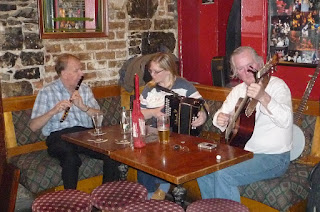Dolan's pub in Limerick

Our entertainment for the evening

On Tuesday we hopped in the car and left Limerick behind. Off we went to County Cork to visit the Blarney Castle and of course to take part in the kissing 'o the stone! The stone is also known as the "Stone of Eloquence". The Blarney Castle is actually the third of structures to have been erected on this site. What blows your mind is that the third structure was built in 1446! The stone; some say it was Jacob’s Pillow, brought to Ireland by the prophet Jeremiah. Here it became the Lia Fail or ‘Fatal Stone’, used as an oracular throne of Irish kings – a kind of Harry Potter-like ‘sorting hat’ for kings. It was also said to be the deathbed pillow of St Columba on the island of Iona. Legend says it was then removed to mainland Scotland, where it served as the prophetic power of royal succession, the Stone of Destiny. When Cormac MacCarthy, King of Munster, sent five thousand men to support Robert the Bruce in his defeat of the English at Bannockburn in 1314, a portion of the historic Stone was given by the Scots in gratitude – and returned to Ireland. Others say it may be a stone brought back to Ireland from the Crusades – the ‘Stone of Ezel’ behind which David hid on Jonathan’s advice when he fled from his enemy, Saul. A few claim it was the stone that gushed water when struck by Moses.
The climb to the castle.

Super Dave goes first and YUP; that's right! You're on your back and you flip your head backwards to kiss the stone.

Germs be damned!! I'm kissing it.

After our walk through the castle and garden grounds we left Cork and drove to County Kilkenny where we stopped in Waterford City; the oldest city in Ireland as it was established in Viking times; circa 914. We stopped for a tasty lunch at the Granary on Merchant's Quay.
Glass engraving artisan Sean Eagan.

We then went to the Waterford Museum of Treasures. Unfortunately the Waterford Crystal Factory is no longer open. Waterford Crystal ceased manufacturing in Waterford City in January 2009. However, if you're planning on traveling to Ireland and this area anytime soon, note that in June a brand new House of Waterford Crystal will be open! Too bad we can't stay longer to enjoy it.
View into Waterford City.

After Waterford City we left for County Wexford and the city of Wexford. Wexford is known for their beaches, being the sunniest county in Ireland, strawberries, the Wexford Festival Opera and writers John Banville, Eoin Colfer, Colm Toibín and Billy Roche. While we were walking through the square this gal stopped us and gave us a welcome packet for an art exhibition at the Wexford College of Art. Turns out she was one of the artisans featured in the exhibit.
Strawberries and modern art.


We drove through Enniscorthy ("Island of the Rocks) and home of my Great Grandfather x5 on my Mom's side on the way to Dublin but didn't stop. It was a long day and we were DONE so we finished up by getting in to Dublin around 8:30 pm. We had dinner at the pub across the street called The Barge Inn. The food was tasty but gave us the distinct impression that while it may appear to be old and historic on the outside; it was definitely a newer pub on the inside.
On Wednesday we had to return our rental car so we drove to the airport and turned it back in. We took a city bus back into the City Center of Dublin and made our way over to Trinity College to the Old Library see the Book of Kells exhibition. The Book of Kells is celebrated for its lavish decoration. The manuscript contains the four Gospels in Latin based on a Vulgate text, written on vellum (prepared calfskin), in a bold and expert version of the script known as "insular majuscule". The place of origin of the Book of Kells is generally attributed to the scriptorium of the monastery founded around 561 by St Colum Cille on Iona, an island off the west coast of Scotland. In 806, following a Viking raid on the island which left 68 of the community dead, the Columban monks took refuge in a new monastery at Kells, County Meath. It must have been close to the year 800 that the Book of Kells was written, although there is no way of knowing if the book was produced wholly at Iona or at Kells, or partially at each location. It has been on display in the Old Library at Trinity College Dublin from the mid 19th century, and attracts over 500,000 visitors a year.
No photography was allowed but here's a shot of the pole banner.

After our cultural exposure we made our way to the heart of the St. James Gate Brewery area for the Guinness Storehouse tour. Evidently when referring to the brand; it's GUINNESS® (all in caps). I tried it but still hated it; I am so not a beer drinker. Dave on the other hand enjoyed it and enjoyed it even more when I turned my pint over to him. (You get a free pint at the end of your tour.)
Super Dave AFTER the two pints!

Tomorrow's journey takes us by train to Belfast. If the weather holds we may try to squeeze in a round of golf on Friday before returning home on Saturday.
Cheers! Pin It Now!

1 comment:
oh miss what fun.
what i would not give for a ploughmans lunch with a guinness!
Post a Comment